In “A Guide to the Most Common Backyard Birds in Iowa,” readers are in for a delightful journey into the vibrant world of birds that grace the backyards of the Hawkeye State. Using data gathered from the citizen science program eBird, this article presents a compilation of the most frequently-spotted feathered friends in Iowa. With stunning pictures and handy identification tips, readers will learn about the Northern Cardinal, the beloved American Robin, and the charming Black-capped Chickadee, which take the top spots in Iowa’s avian pecking order. But that’s not all! This article also offers insights on how to attract these birds to your very own backyard, and valuable resources for further bird watching adventures in Iowa. So grab your binoculars and get ready to be dazzled by the beauty and wonder of Iowa’s backyard birds.
1. Northern Cardinal
The Northern Cardinal is one of the most vibrant and eye-catching backyard birds you can find in Iowa. It is easily distinguishable by its bright red plumage, crest on its head, and black mask on its face. The male Northern Cardinal is known for its vibrant red color, while the female has a more muted reddish-brown color with hints of red. Its beak is short and conical and it has a long, pointy tail.
This species of bird can be found throughout Iowa and is commonly seen in woodlands, gardens, and suburban areas. They are often found in dense shrubs and trees, but are also commonly seen near bird feeders and on the ground searching for food. The Northern Cardinal can adapt to a wide range of habitats, making it a familiar sight for many bird enthusiasts.
In terms of behavior, the Northern Cardinal is known for its clear, whistling song. Males often sing from high perches to attract mates and establish their territory. They are also known for their aggressive behavior towards other birds, especially during the breeding season. They will defend their territory vigorously, often engaging in “territorial battles” with other males.
If you want to attract Northern Cardinals to your backyard, there are a few things you can do. Providing a variety of feeders with seeds such as sunflower, safflower, and millet can help attract these birds. They are also known to eat fruits and berries, so having fruit trees or shrubs in your backyard can be enticing. Adding dense shrubs and trees for nesting and cover will also make your backyard more appealing to Northern Cardinals.
2. American Robin
The American Robin is a familiar bird to many people, known for its distinctive red breast and cheerful song. It is larger than the Northern Cardinal, with a plump body and long legs. Its back and head are a dark greyish-brown color, and its belly is white. The male and female American Robin look very similar, making it difficult to tell them apart.
American Robins can be found throughout Iowa, as they are a highly adaptable species. They are commonly found in open woodlands, gardens, parks, and even urban areas. They are also known to migrate, so you might see them in your backyard during the spring and summer months, but not during the colder winter months.
The behavior of American Robins is quite interesting. They are known for their “worm-pulling” behavior, where they search for earthworms by tugging on the ground with their beak. They will also eat other insects, berries, and fruits. American Robins are known to be social birds and are often seen in large flocks, especially during migration.
To attract American Robins to your backyard, providing a water source such as a birdbath or a small pond can be enticing. They also enjoy open spaces with short grass, as this makes it easier for them to spot earthworms. Planting fruit trees or shrubs that produce berries can also attract American Robins, as they are fond of fruits.
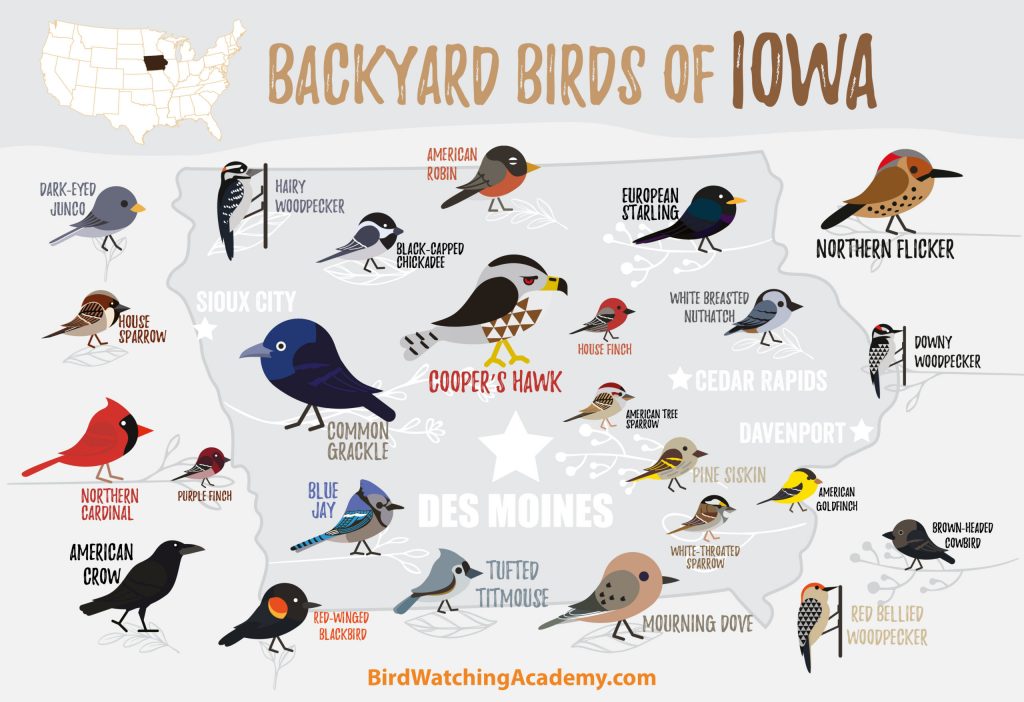
3. Black-capped Chickadee
The Black-capped Chickadee is a small, lively bird with a distinctive black cap and bib, white cheeks, and a grayish body. It has a short, stubby bill and a long tail. These birds are known for their acrobatic moves and can often be seen hanging upside down or hopping from branch to branch in search of food.
Black-capped Chickadees are widespread throughout Iowa and can be found in a variety of habitats, including woodlands, parks, and suburban areas. They are known for their adaptability and can be found in both coniferous and deciduous forests. They are also common visitors to backyard bird feeders.
In terms of behavior, Black-capped Chickadees are highly vocal and have a distinctive call that sounds like “chick-a-dee-dee-dee.” They are also known for their ability to cache food, meaning they store food for later consumption. They are curious and intelligent birds, and are known to investigate new objects in their environment.
To attract Black-capped Chickadees to your backyard, providing a variety of feeders with seeds such as sunflower and nyjer can be effective. They are also attracted to suet feeders, as they enjoy the high-fat content of suet. Planting native trees and shrubs that produce berries can also provide a natural food source for these birds.
4. Blue Jay
The Blue Jay is a stunning bird with a vibrant blue crest on its head, as well as blue wings and tail feathers. It has a white face and black markings around its eyes, giving it a distinct appearance. Blue Jays are medium-sized birds with a robust build and a strong beak.
Blue Jays can be found throughout Iowa, particularly in forests, woodlands, and suburban areas with dense trees. They are often seen perched on branches or flying with slow, steady wingbeats. They are known to migrate, so you might see them in your backyard during certain times of the year.
In terms of behavior, Blue Jays are highly vocal birds and are known for their loud and harsh calls. They are also excellent mimics and can imitate other bird species and even human voices. Blue Jays are omnivorous and eat a wide variety of foods, including acorns, nuts, insects, and small vertebrates. They are also known to steal eggs and nestlings from other bird species.
To attract Blue Jays to your backyard, providing a variety of feeders with peanuts, sunflower seeds, and suet can be effective. They are also attracted to water sources, so having a bird bath or a shallow pond can be enticing. Blue Jays will also appreciate shrubs and trees for cover and nesting sites.
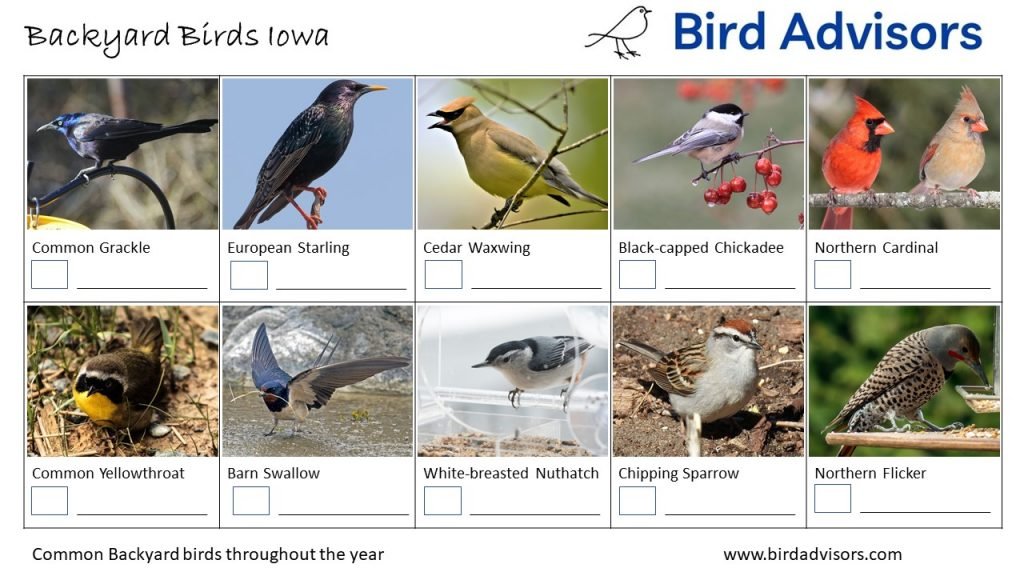
5. Mourning Dove
The Mourning Dove is a graceful and gentle bird with a soft, soothing cooing sound. It has a slender body with a long, pointed tail and a small head. The plumage of the Mourning Dove is a pale gray color, with black spots on its wings. Both males and females look similar, with the male having a slightly more vibrant plumage.
Mourning Doves can be found throughout Iowa, particularly in open areas such as fields, meadows, and gardens. They are also commonly seen in urban areas, where they will nest on buildings and rooftops. Mourning Doves are known for their distinctive flight pattern, with a swift and direct flight.
The behavior of Mourning Doves is quite peaceful and serene. They are often seen perched on telephone wires or feeding on the ground. They primarily eat seeds, especially those of grasses and grains. Mourning Doves also have a unique nesting behavior, as they build flimsy nests made of twigs and these nests can often be found on open branches or even on the ground.
To attract Mourning Doves to your backyard, providing a ground feeder with a mix of seeds such as millet and cracked corn can be effective. They are also attracted to platform feeders and will readily eat sunflower seeds. Having open spaces with bare ground or low-growing plants can also make your backyard more appealing to Mourning Doves.
6. House Finch
The House Finch is a small and colorful bird with a mix of pink, red, and brown feathers. The male House Finch has a vibrant red coloration on its head and chest, while the female has a more subdued coloration, with streaks and spots. They have a conical beak, perfect for cracking open seeds.
House Finches can be found throughout Iowa, particularly in urban areas, gardens, and parks. They are known to be adaptable and can be seen in a variety of habitats, including woodlands and grasslands. They are often seen perched on branches or feeding on the ground.
In terms of behavior, House Finches are social birds and are often seen in flocks. They have a melodious yet warbling song, and the males often sing to attract females and establish their territory. They primarily eat seeds, especially those of fruits, flowers, and grasses. House Finches are also known to eat insects during the breeding season.
To attract House Finches to your backyard, providing a variety of feeders with seeds such as sunflower, nyjer, and millet can be effective. They will also appreciate fruit trees or shrubs that produce berries. House Finches are also known to build nests in a variety of locations, so having shrubs and trees with dense foliage can provide suitable nesting sites.
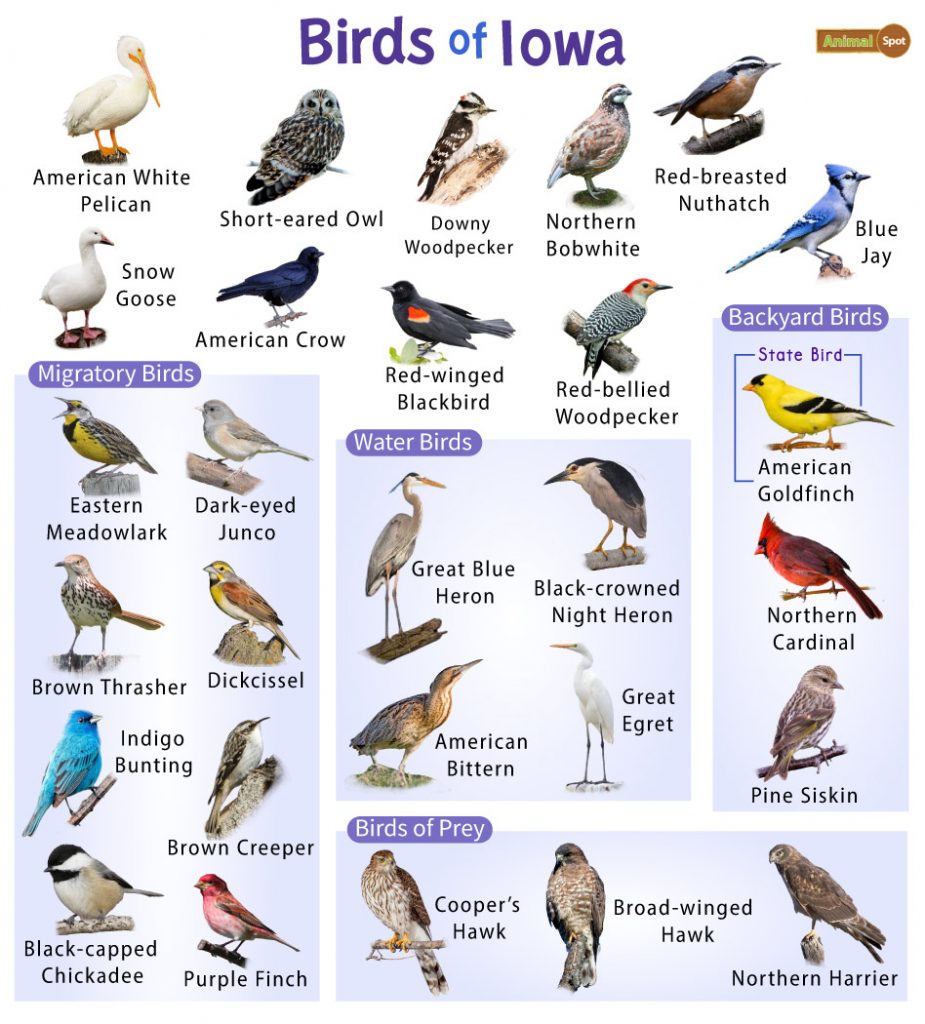
7. American Goldfinch
The American Goldfinch is a small bird with bright yellow plumage and black wings. It has a conical beak and a small head, giving it a distinctive appearance. During the breeding season, the male American Goldfinch has a vibrant yellow color, while the female has a more muted yellow color with hints of gray.
American Goldfinches can be found throughout Iowa, particularly in open areas such as fields, meadows, and gardens. They are often seen perched on thistles and other plants, feeding on seeds. They are known for their characteristic undulating flight pattern.
In terms of behavior, American Goldfinches are highly social birds and are often seen in flocks. They have a musical and melodic song, often described as a series of tinkling notes. They primarily eat seeds, especially those of thistles, sunflowers, and other plants. American Goldfinches also eat insects, especially during the breeding season.
To attract American Goldfinches to your backyard, providing a variety of feeders with nyjer and sunflower seeds can be effective. They are also known to eat dandelion seeds, so having a few dandelion plants can be enticing. Planting native wildflowers, such as milkweed and coneflowers, can provide a natural food source for these birds.
8. Downy Woodpecker
The Downy Woodpecker is a small yet charismatic bird with a black and white plumage. It has a white belly and face, with black wings and a black striped pattern on its back. The male Downy Woodpecker has a small and inconspicuous red patch on the back of its head.
Downy Woodpeckers can be found throughout Iowa, particularly in forests, woodlands, and suburban areas with trees. They are often seen perched on tree trunks or branches, using their strong beaks to peck at the bark in search of insects. They are known for their drumming behavior, where they tap on trees to communicate and establish their territory.
In terms of behavior, Downy Woodpeckers are highly acrobatic birds and can be seen clinging to tree trunks and branches in various positions. They primarily eat insects, especially those that live within the bark of trees. They also eat seeds, berries, and fruits.
To attract Downy Woodpeckers to your backyard, providing suet feeders can be effective, as they are attracted to the high-fat content of suet. They are also known to eat peanuts and sunflower seeds, so having a variety of feeders can cater to their dietary preferences. Having dead or decaying trees in your backyard can also provide suitable nesting and foraging sites for these woodpeckers.
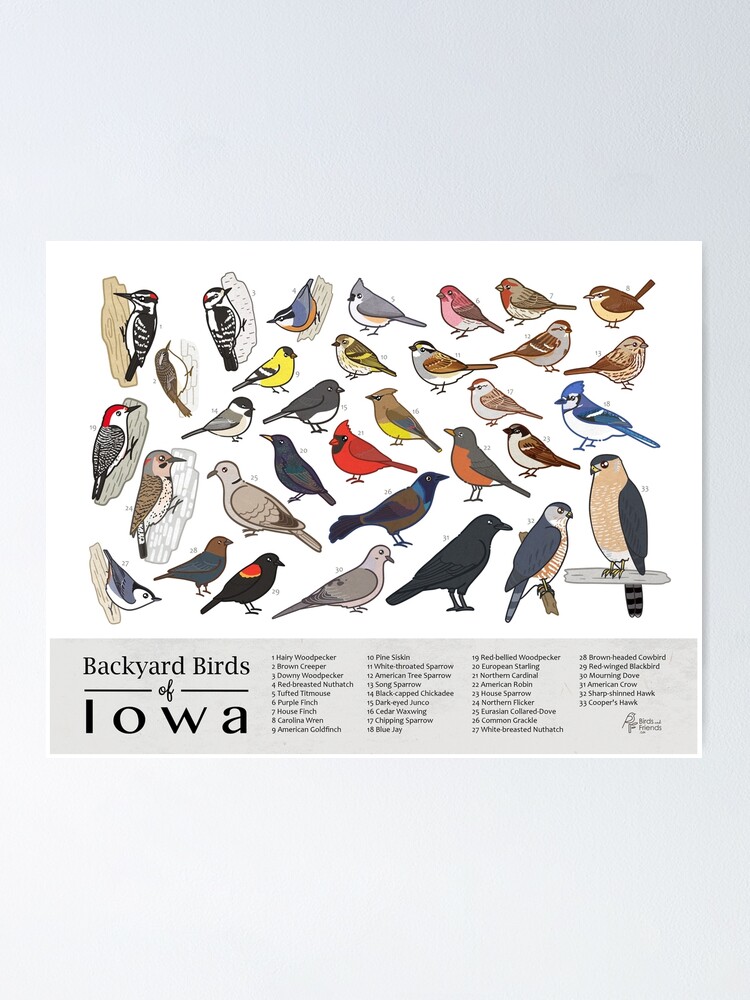
9. Red-winged Blackbird
The Red-winged Blackbird is a medium-sized bird with a striking black plumage and bright red and yellow shoulder patches. The male Red-winged Blackbird has a distinct call that sounds like “conk-a-ree!” and is often heard during the breeding season. The female has a more subdued coloration with dark streaks on her breast.
Red-winged Blackbirds can be found throughout Iowa, particularly in marshes, wetlands, and grassy areas. They are often seen perched on cattails or other reeds, and the males are known to defend their nesting territories vigorously. They are migratory birds, so you might see them in your backyard during certain times of the year.
In terms of behavior, Red-winged Blackbirds are highly social and are often seen in large flocks. They have a unique nesting behavior, where the females build cup-shaped nests among cattails or other vegetation. They primarily eat insects, seeds, and berries, and are known to forage both on the ground and in the water.
To attract Red-winged Blackbirds to your backyard, providing a water source such as a birdbath or a small pond can be effective. They are also attracted to feeders with seeds such as sunflower, millet, and cracked corn. Having a variety of native grasses and emergent vegetation in your backyard can also provide suitable nesting and foraging sites for these birds.
12. Resources for Further Bird Identification
If you’re interested in learning more about the birds in your backyard or in Iowa in general, there are several resources available to help you identify them and learn more about their behavior and habitat requirements.
Field Guides
Field guides are an excellent resource for identifying birds. They typically include detailed information on bird species, including descriptions, illustrations, and range maps. Some popular field guides for North American birds include “The Sibley Guide to Birds” by David Allen Sibley and “National Geographic Field Guide to the Birds of North America” by Jonathan Alderfer.
Websites
There are also several websites that provide valuable information on bird identification. Websites such as eBird.org and AllAboutBirds.org, both managed by the Cornell Lab of Ornithology, provide comprehensive bird identification guides, as well as information on bird behavior, habitat, and conservation.
Local Birding Groups
Joining a local birding group or participating in birding events can be a great way to learn more about birds in your area. These groups often organize bird walks, host guest speakers, and provide opportunities for networking with other bird enthusiasts. The Iowa Ornithologists’ Union and the Iowa Audubon Society are two organizations that promote birding and conservation in Iowa.
In conclusion, Iowa is home to a diverse array of backyard birds, each with its own unique characteristics, habitat requirements, and behavior patterns. By providing the right food, water, and habitat features in your backyard, you can create an inviting environment for these beautiful birds to visit and thrive. Whether you’re a beginner or an experienced bird watcher, there are plenty of resources available to help you identify and learn more about the birds in your backyard and beyond. So grab your binoculars and get ready to discover the fascinating world of backyard birding in Iowa!
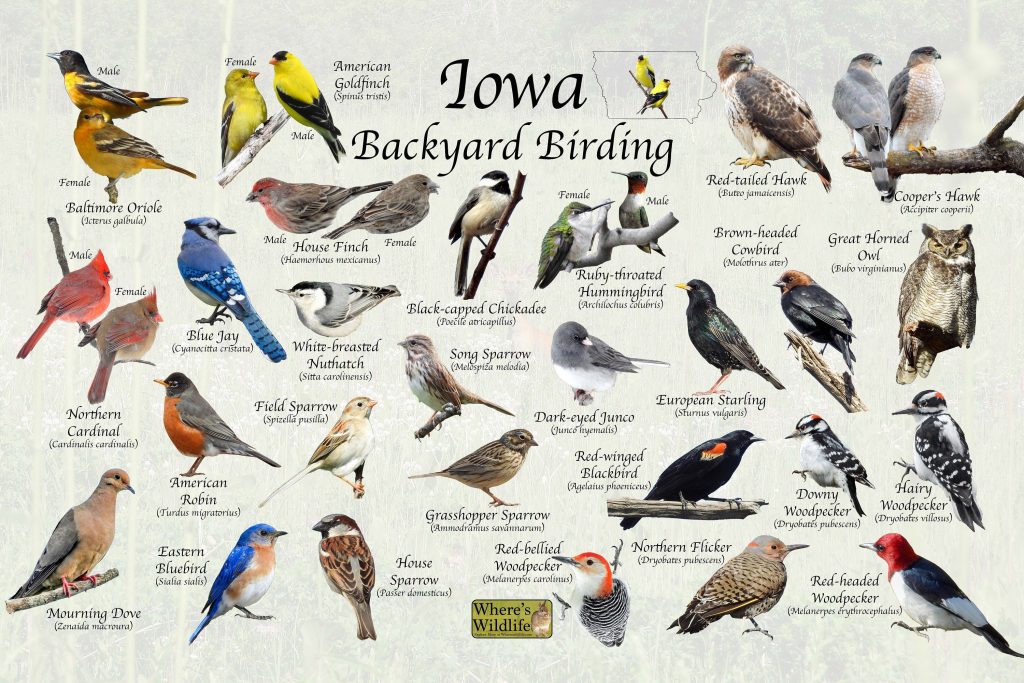
Leave a Reply